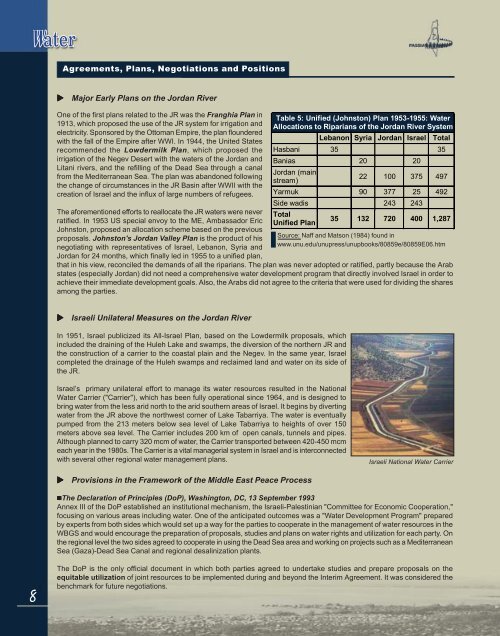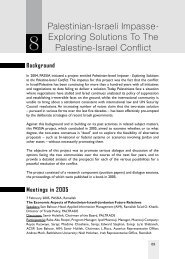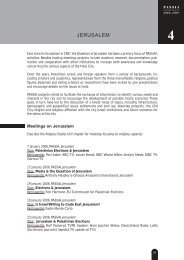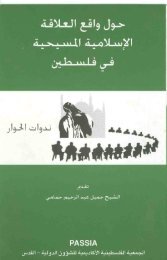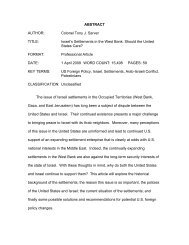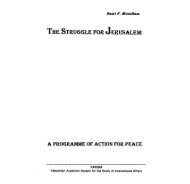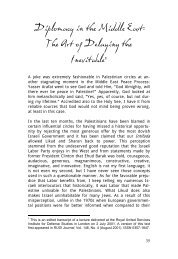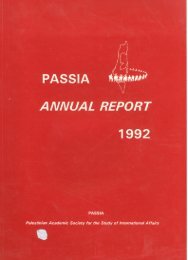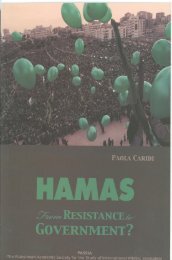Water - PASSIA
Water - PASSIA
Water - PASSIA
You also want an ePaper? Increase the reach of your titles
YUMPU automatically turns print PDFs into web optimized ePapers that Google loves.
Agreements, Plans, Negotiations and Positions<br />
! Major Early Plans on the Jordan River<br />
One of the first plans related to the JR was the Franghia Plan in<br />
1913, which proposed the use of the JR system for irrigation and<br />
electricity. Sponsored by the Ottoman Empire, the plan floundered<br />
with the fall of the Empire after WWI. In 1944, the United States<br />
recommended the Lowdermilk Plan, which proposed the<br />
irrigation of the Negev Desert with the waters of the Jordan and<br />
Litani rivers, and the refilling of the Dead Sea through a canal<br />
from the Mediterranean Sea. The plan was abandoned following<br />
the change of circumstances in the JR Basin after WWII with the<br />
creation of Israel and the influx of large numbers of refugees.<br />
The aforementioned efforts to reallocate the JR waters were never<br />
ratified. In 1953 US special envoy to the ME, Ambassador Eric<br />
Johnston, proposed an allocation scheme based on the previous<br />
proposals. Johnston's Jordan Valley Plan is the product of his<br />
negotiating with representatives of Israel, Lebanon, Syria and<br />
Jordan for 24 months, which finally led in 1955 to a unified plan,<br />
Table 5: Unified (Johnston) Plan 1953-1955: <strong>Water</strong><br />
Allocations to Riparians of the Jordan River System<br />
Lebanon Syria Jordan Israel Total<br />
Hasbani 35 35<br />
Banias 20 20<br />
Jordan (main<br />
stream)<br />
22 100 375 497<br />
Yarmuk 90 377 25 492<br />
Side wadis 243 243<br />
Total<br />
Unified Plan<br />
35 132 720 400 1,287<br />
Source: Naff and Matson (1984) found in<br />
www.unu.edu/unupress/unupbooks/80859e/80859E06.htm<br />
that in his view, reconciled the demands of all the riparians. The plan was never adopted or ratified, partly because the Arab<br />
states (especially Jordan) did not need a comprehensive water development program that directly involved Israel in order to<br />
achieve their immediate development goals. Also, the Arabs did not agree to the criteria that were used for dividing the shares<br />
among the parties.<br />
! Israeli Unilateral Measures on the Jordan River<br />
In 1951, Israel publicized its All-Israel Plan, based on the Lowdermilk proposals, which<br />
included the draining of the Huleh Lake and swamps, the diversion of the northern JR and<br />
the construction of a carrier to the coastal plain and the Negev. In the same year, Israel<br />
completed the drainage of the Huleh swamps and reclaimed land and water on its side of<br />
the JR.<br />
Israel’s primary unilateral effort to manage its water resources resulted in the National<br />
<strong>Water</strong> Carrier ("Carrier"), which has been fully operational since 1964, and is designed to<br />
bring water from the less arid north to the arid southern areas of Israel. It begins by diverting<br />
water from the JR above the northwest corner of Lake Tabarriya. The water is eventually<br />
pumped from the 213 meters below sea level of Lake Tabarriya to heights of over 150<br />
meters above sea level. The Carrier includes 200 km of open canals, tunnels and pipes.<br />
Although planned to carry 320 mcm of water, the Carrier transported between 420-450 mcm<br />
each year in the 1980s. The Carrier is a vital managerial system in Israel and is interconnected<br />
with several other regional water management plans.<br />
Israeli National <strong>Water</strong> Carrier<br />
! Provisions in the Framework of the Middle East Peace Process<br />
"The Declaration of Principles (DoP), Washington, DC, 13 September 1993<br />
Annex III of the DoP established an institutional mechanism, the Israeli-Palestinian "Committee for Economic Cooperation,"<br />
focusing on various areas including water. One of the anticipated outcomes was a "<strong>Water</strong> Development Program" prepared<br />
by experts from both sides which would set up a way for the parties to cooperate in the management of water resources in the<br />
WBGS and would encourage the preparation of proposals, studies and plans on water rights and utilization for each party. On<br />
the regional level the two sides agreed to cooperate in using the Dead Sea area and working on projects such as a Mediterranean<br />
Sea (Gaza)-Dead Sea Canal and regional desalinization plants.<br />
8<br />
The DoP is the only official document in which both parties agreed to undertake studies and prepare proposals on the<br />
equitable utilization of joint resources to be implemented during and beyond the Interim Agreement. It was considered the<br />
benchmark for future negotiations.


